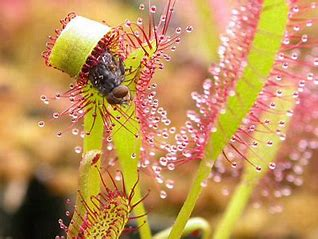Here are 10 carnivorous plants known for their ability to devour living creatures, usually insects and small animals:
1. Venus Flytrap (Dionaea muscipula)
- Habitat: Native to subtropical wetlands in the United States.
- Prey: Insects and arachnids.
- Mechanism: Its iconic "trap" consists of hinged lobes lined with teeth. When an unsuspecting insect touches its sensitive hairs, the trap snaps shut, imprisoning the prey.
2. Pitcher Plants (Nepenthes and Sarracenia species)
- Habitat: Found in tropical regions, bogs, and marshes.
- Prey: Insects, but larger species can catch small mammals, birds, and amphibians.
- Mechanism: They lure prey into deep, slippery pitchers filled with digestive fluids. Once inside, the prey drowns and is slowly digested.
3. Sundew (Drosera species)
- Habitat: Found in many environments worldwide, including Europe and Australia.
- Prey: Mostly small insects.
- Mechanism: Sticky, glandular hairs on its leaves trap insects. The plant slowly curls around its prey, secreting enzymes to break it down.
4. Butterwort (Pinguicula species)
- Habitat: Europe, North America, and South America.
- Prey: Small insects.
- Mechanism: Its leaves are covered with a greasy, sticky substance that traps insects. The plant then digests them with secreted enzymes.
5. Bladderwort (Utricularia species)
- Habitat: Found in aquatic or moist environments worldwide.
- Prey: Tiny aquatic creatures, including protozoans and small crustaceans.
- Mechanism: It has tiny underwater bladders that suck in prey when hair triggers are disturbed.
6. Waterwheel Plant (Aldrovanda vesiculosa)
- Habitat: Aquatic environments in Europe, Asia, and Africa.
- Prey: Aquatic insects and small invertebrates.
- Mechanism: Similar to the Venus flytrap, but underwater. It snaps shut on small aquatic creatures when its sensitive hairs are triggered.
7. Cobra Lily (Darlingtonia californica)
- Habitat: Native to North America's west coast, in boggy regions.
- Prey: Insects.
- Mechanism: The plant's tubular leaves resemble a cobra's hood. Insects are lured in and become disoriented by its maze-like interior before falling into digestive fluids.
8. Albany Pitcher Plant (Cephalotus follicularis)
- Habitat: Southwestern Australia.
- Prey: Insects.
- Mechanism: Similar to the pitcher plant, it uses a fluid-filled trap to drown and digest prey.
9. Broccoli Sundew (Drosera schizandra)
- Habitat: Rainforests of Australia.
- Prey: Insects.
- Mechanism: This rare species uses sticky dew-covered leaves to ensnare prey, like other sundews.
10. Roridula (Roridula species)
- Habitat: South Africa.
- Prey: Large insects, but also indirectly benefits from small animals that feed on trapped prey.
- Mechanism: While it cannot digest prey directly, it traps insects with sticky resin and relies on symbiotic bugs (Pameridea) to consume the prey and leave nutrient-rich waste for the plant.
These fascinating carnivorous plants have evolved unique mechanisms to thrive in nutrient-poor environments by capturing and digesting living creatures.











0 Response to "10 Carnivorous Plants That Devour Living Creatures"
Post a Comment